JAMES STROTHER, PH.D.

James Strother, Ph.D.
Assistant Professor of Biology
Dr. James Strother graduated from UC Berkeley with a Bachelor’s degree in Physics. He earned his Ph.D. in biology from UC Irvine, and was a postdoctoral fellow at Janelia Research Campus HHMI. He started his own lab at Oregon State University, and he recently moved to the Whitney Lab as an Assistant Professor of Biology.
Research
The Strother Lab focuses on questions at the interface between neurobiology and physiology using fishes as model organisms. Our lab is especially interested in understanding processes at multiple levels of organization, from the properties of individual cells up to the responses of the whole animal. Current projects in the lab examine a range of topics, including nervous control of the cardiovascular system, the effects of stress on animal behavior, and sensory physiology. Many of our projects leverage zebrafish larvae as a model system, since their small size, transparency, and genetics toolkit enables unique experimental approaches. Some of the tools used in our lab include in vivo imaging of neuron activity, optogenetics, quantitative behavioral assays, electrophysiology, and computational modeling.
Image: Neural activity map for a zebrafish
Biomechanics of Filter Feeding
Our lab includes individuals with backgrounds in biology, physics, and engineering who work together to explore the emergent properties of complex systems. In a recent project, we examined the physics of filter feeding in manta rays, during which these animals bring large volumes of water into their mouth, extract microscopic plankton, and then expel the remaining water through the gill slits. We found that manta rays employ a novel fluid-particle separation mechanism that had not previously been described in either the biological or engineering literature. As water passes over the filtering apparatus, it induces captive vortices between the lobes of the filter and these vortices drive particles to impact and ricochet away from the filter. This mechanism is believed to allow manta rays to filter vast quantities of water with minimal clogging effects. Ongoing projects examine how the morphology of the filtering apparatus affect these processes and explore whether this mechanism can be leveraged in industrial designs. Image: Fluid streamlines and particle trajectories calculated with computational fluid dynamics.

Manta ray images credit: Stephen Kajiura

